Broken News
(All the News That's Fit to Reprint)
Petrol Prices
 |
The Idle RECOPE Refinery |
Costa Rica has a refinery but doesn't run it, ostensibly for environmental concerns. Instead the government imports, distributes and controls the price of all gasoline sold here. The state-run refining company - RECOPE (Refinadora Costarricense de Petróleo, S.A.), that is supposed to refine oil into gasoline, instead distributes imported gasoline to retailers. The result is a government-run monopoly some Costa Ricans would love to change.
Another government agency called ARESEP regulates the price of gasoline, among many other things. ARESEP stands for Autoridad Reguladora de los Servicios Públicos. (Costa Ricans love acronyms almost as much as I do alliteration) In the last few years, when gas prices were rising dramatically around the world, ARESEP was quick to increase the price every month. Now that prices have been falling globally and dramatically in the past year, they have not been as quick to follow suit.
 A case in point: In late September, ARESEP announced that in October, the price of regular gasoline would drop to 540 colones per liter. At 530 colones to the dollar, that is equivalent to $3.83 per gallon. This struck me particularly high because two weeks earlier I paid $2.20 per gallon to fill up a rental car in Florida.
A case in point: In late September, ARESEP announced that in October, the price of regular gasoline would drop to 540 colones per liter. At 530 colones to the dollar, that is equivalent to $3.83 per gallon. This struck me particularly high because two weeks earlier I paid $2.20 per gallon to fill up a rental car in Florida.
It appears that ARESEP has its own arithmetic for determining the price for gasoline that is not directly reflective of world oil prices. I suspect that not wanting to give up the income windfall the government is enjoying as a result of declining world oil prices has something to do with it.
Whopper No Mas
 Last month the Chronicles did a feature (see Arcos Dorados) on the rapidly changing fast food industry in Costa Rica including a number of chain closings like Wendy's and Bagelman's. At that time it was reported that Burger King had trimmed the number of their restaurants from 33 to 29 but would otherwise continue operations.
Last month the Chronicles did a feature (see Arcos Dorados) on the rapidly changing fast food industry in Costa Rica including a number of chain closings like Wendy's and Bagelman's. At that time it was reported that Burger King had trimmed the number of their restaurants from 33 to 29 but would otherwise continue operations.
BKC-US (a shareholder in BK-CR) evidently didn't see it that way for long and, in the first days of October, it was announced that the entire operation would be shuttered. There'll be no more Whoppers in Costa Rica, amigos, Whoppers No Mas. At least not for awhile.
While this is not much of a personal issue as there is no Burger King in our area, just in the central valley, it might be time for the political powers in San José to start asking serious questions on why more and more companies in Costa Rica are finding it harder and harder to do business here.
A few days after the official announcement that BK was pulling out of Costa Rica, the BKC-US corporate office issued a statement that promised BK would return to Costa Rica in the future. This seemed to reinforce the notion that the problem was indeed a disagreement between corporate folk and franchisee folk on how to run the local chain. Not to be left behind, smaller burger chains like Carl's Jr. (eight locations in Costa Rica) and Johnny Rockets (three stores) quickly said they will continue to expand. And, at about the same time, KFC announced it will open seven new restaurants in the coming year (Ticos really love chicken) while Taco Bell expects four new locations.
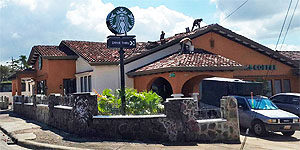 |
Newest CR Starbucks Has a Drive-Thru |
Starbucks, with eight existing locations, also sounded optimistic saying 15 new stores are planned in the next five years. Who'd a thunk Starbucks could make it in a country that grows and serves its own great coffee? But we have to remember that some 30-50% of Starbucks bean consumption chain-wide comes from Ticoland.
Looks like the fast-food industry is secure here and, of course, I'm always a bit jealous as none of the aforementioned companies yet has an operation in Quepos.
Dolphin "Super" Pod
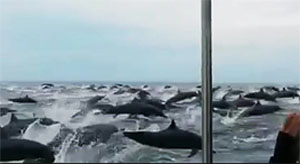 September/October is a time along this coast when large numbers of whales and dolphins appear. It's mating time.
September/October is a time along this coast when large numbers of whales and dolphins appear. It's mating time.
The picture to the left was taken from a boat in southwest Costa Rica when the boaters caught a "super pod" of dolphins frolicking in the pacific. Dolphins, often described by those that know them best as very intelligent creatures, travel in groups called pods, but when a number of groups cross paths, it can result in a “super pod.”
To see the actual video of this super pod, go here. To read more about the south pacific coast of Costa Rica, go here: A Personal Corcovado Adventure
Quepos Quickies
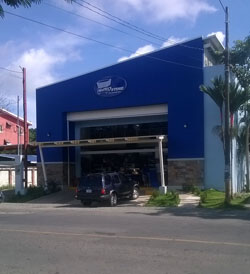 |
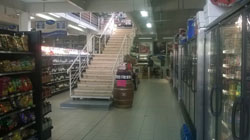 |
The New Mini-Price Store |
Expanded Supers. In last December's edition, the Chronicles noted that three of the four major supermarkets in Quepos, i.e., Mini-Price Store, Super Jordix and Super 2000 were all actively undergoing expansion and renovation at the same time. We entitled the article Super Expansion Fever.
All three markets have completed their expansions and all of them have produced significantly improved and expanded facilities. All three of them now offer a cleaner, brighter place to shop, although Super 2000 for a short period decided to shut off the lights during the day, I suppose to save electricity and lower the temperature. Thankfully that didn't last long; shadows and darkness don't enhance the buying process.
What there doesn't appear to be, in any of the new markets, is an expansion of offerings or broadening of products, even though the floor space in each case has increased significantly. Yet, each market seems to have retained its original strengths.
Super Jordix remains that stereotypically friendly neighborhood market with all the basics in meat, produce and groceries. Its chief strength lies in its availability, as it's open from 6 AM in the morning until 10 PM at night, 364 days per year. It only closes on Christmas Day. I'm fortunate in that it's only two blocks away from my apartment for those emergency runs, like getting an ice cream sandwich on the way to the futbol game.
Super 2000, on the other hand, is a whole three and a half blocks away. This is the busiest of the three markets, often showing four register lines active while the other two make due with two each. I find this market particularly good for (typical tico) meats and it has a strong produce section with some above-average quality fruits like ciruellas (plums) and madarinas (tangerines).
Mini-Price store still is strong in imported items. It's the only place I can find certain things like large blocks of cheddar, swiss and pepper-jack cheese or large jars of small dill pickles and stuffed Spanish olives or bagels. It has added a produce section and some frozen imported meats, as well as the beginnings of a deli and pasteleria for sweet desserts and coffee on the premises (reminiscent of the old Super Mas) but hasn't quite completed the idea yet.
Yeah , I know you dudes that live in large cities, or places with an infinite variety and selection, like the U.S., think my recount here is quaint, but believe me amigo, this stuff is a big deal in a small town.
And I love this small town stuff.
Chronicles Additions and Improvements. Since its inception in 2008, the Golden Gringo Chronicles has endeavored to maintain two main objectives: 1) to be informative and 2) to be entertaining. Two changes in this edition further those goals.
 A new department has been added this month called ¿Que Es Eso?, Spanish for "What is that?". It occurred to GG (GG = the Golden Gringo, the GGC Editor, also known as me) that I see interesting things everyday here that might be a bit of a riddle to those of you who don't live here or who may not have seen these items.
A new department has been added this month called ¿Que Es Eso?, Spanish for "What is that?". It occurred to GG (GG = the Golden Gringo, the GGC Editor, also known as me) that I see interesting things everyday here that might be a bit of a riddle to those of you who don't live here or who may not have seen these items.
In each edition we will try to feature a picture of an item and see if you can guess what it is. The answer will be in the What's-in-a-Word section near the end of each edition.
 The second improvement has to do with making it easier to access the considerable amount of information contained in the Golden Gringo Chronicles Archives. Spanning all the departments and the more than 170 feature articles in the 87 editions to date, it comes to almost 500,000 words or about 9 average length novels according to Amazon. This edition alone clocks in at more than 7,100 words.
The second improvement has to do with making it easier to access the considerable amount of information contained in the Golden Gringo Chronicles Archives. Spanning all the departments and the more than 170 feature articles in the 87 editions to date, it comes to almost 500,000 words or about 9 average length novels according to Amazon. This edition alone clocks in at more than 7,100 words.
To help readers access all the background information, Archives have been created which organize and link the information by chronological order of the editions, latest first (Edition Archive), by subject or topic (Archive Topical Index) and for ROMEO restaurant reviews (Restaurant Archives).
Starting this month we've also added a Google search routine that can be found on the various archive pages as well as on this and future editions and the main website page at www.goldengringo.com. Try out the search routine below, simply type in a keyword or phrase and click the search button. The system will return a set of edition links where you can find the item you searched for. You may have to scan through the edition to find the topic (my website developer tells me it will take some special programming, i.e., money, to get a routine that pulls up the reference at the exact position in the document where it appears - maybe later).
Suggestion on using the search routine: make your keyword or phrase as simple and precise as possible.
¡Pura Vida!
Rumble Talk
(Shaky Happenings On or About the Pacific Rim)
Quake Outside Quepos - Really?
The University of Costa Rica Siesmic Engineering Laboratory reported a 4.6 magnitude earthquake centered in the hills above Quepos at 11:51 on the morning on October 1. According to press reports it was felt in the central valley including San José. Really? GG didn't feel a thing that day living in Quepos. Funny how these things propagate in different directions.
Turrialba Rumbling and Quaking Again
Volcan Turrialaba, which has been quiet for a couple of months after several noisy and ash spewing months before that, came alive again on October 15 spewing ash in a radius of two or more kilometers and registering strongly on the seismometers. Then on October 24 at five in the morning it erupted again. To see that last eruption, go here:
https://www.facebook.com/OVSICORI/videos/905231062847486/
Check Out Recent Earthquakes Around the World
Posted by the U.S. Geodetic Survey: Today's Quakes |
TOP
¿Que Es Eso? Department
(What is that?)
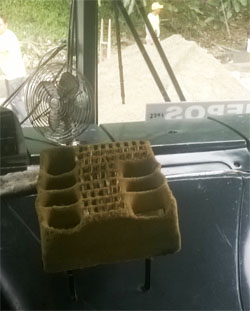 ¿Que Es Eso? is Spanish for "What is that?". This department is new to the Chronicles with this month's issue. In it we will try to highlight, with photos, those things that seem common in Costa Rica life, particularly in Quepos and Manuel Antonio, but are probably not to be found elsewhere.
¿Que Es Eso? is Spanish for "What is that?". This department is new to the Chronicles with this month's issue. In it we will try to highlight, with photos, those things that seem common in Costa Rica life, particularly in Quepos and Manuel Antonio, but are probably not to be found elsewhere.
 |
Life is what happens while your looking at your cell phone |
Can you guess what the item pictured to the left is? Hint - it has to do with transportation but is not a cut-away of a mold of the internal parts of a combustion engine (7-cylinder) which I think it looks a bit like.
Answer to this week's ¿Que Es Eso? riddle is below in the What's-in-a-Word section.
TOP
Va Pues
(Cavorting in Nicaragua, Once Again)
About four years ago some friends started an annual meeting in Nicaragua in San Juan del Sur, a small town about the size of Quepos located on the Pacific coast. It's called a Round-Up and it's kind of a retreat for men (seriously, it's more like a retreat than a fling because these dudes don't drink or use drugs - nuff said?). It's simply a weekend for camaraderie and fellowship and for about a 1/3 of them, it's an opportunity to smoke some good cigars (no longer for GG though - sniffle).
Five of us from the Quepos/Manuel Antonio area decided to travel together to participate in the Round-Up and since none of us own cars, we went by bus. To be more precise, we took three busses (Quepos to Puntarenas - 2:30 hours, Puntarenas to Liberia - 3:15, Liberia to Peñas Blancas at the border - 1:30). After processing through immigration lines, we took taxis (two for five people) from the Nicaraguan side of the border to the town. The total distance from Quepos to San Juan del Sur is about 315 kilometers or 180 miles (as the Google-Earth osprey flies).
By bus it's considerably longer in distance and time, like 10 hours worth, although I was impressed once again at how little time we had to waste between bus transfers. Part of the total travel time required has to do with the fact that these busses are "collectivos" which means they stop at any bus stop where a passenger wants to get on or off. The busses also drive through a few communities along the way like Jacó, Quebrada Ganado ("Cattle Creek"), Bagaces and Cañas.
This is a good time of the year to cross a border almost anywhere in Central America; it's low season and there are fewer crowds. And, from experience, Peñas Blancas (which means "White Cliffs" - the cliffs are somewhere in the area) has always been easy to cross compared to other border crossings, such as Paso Canoas at Panama in the south for example.
There may be an exception - I couldn't help but notice a very large number of 18 wheelers parked, two wide, side by side on both sides of the highway pointing north towards Nicaragua. My guess was that the group of trucks was at least 150 vehicles total. I was glad I wasn't a trucker having to go through that line.
But for we foot soldiers it was easy. We walked into the Costa Rica immigration center, fought with an electronic machine that looks like an ATM, paying our $7 exit tax and presented receipts and passports to an immigration clerk who stamped it after passing the document through a scanner. (GG believes it's always also good to flash one's cédula or residency document in these places) The five of us were processed through the Costa Rican side in less than a half hour. The luggage inspection room was empty so I just walked on, never having opened my mochilla (backpack).
The next step was to walk about half a kilometer north along the main highway to get to the Nicaragua immigration center. The lines were a little longer there but we were in front of a clerk within ten minutes. In this room one paid a $1 entrance tax to the border town followed by a $14 fee to the country. After that, one passed the bag through a scanner and we were soon able to be outdoors on the Nicaraguan side and free to haggle with taxi drivers. We had been constantly solicited by these drivers when we were only half way up the road between the two immigration centers. We tried to get an SUV type taxi which would have been able to handle all five of us but none was to be had so we ended up hiring two regular sized taxis. By the time we selected the cars, at least five of these (very polite) entrepreneurs had been at us and some had to be disappointed, unfortunately.
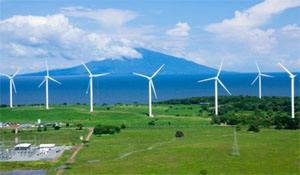 The ride from the border to San Juan del Sur takes less than an hour and the typical fare, we would learn later, is $20-25 although we paid a little more on this trip. Splitting the two fares among several of us made it very reasonable. On our return trip three of us paid a total of only $20 plus tip.
The ride from the border to San Juan del Sur takes less than an hour and the typical fare, we would learn later, is $20-25 although we paid a little more on this trip. Splitting the two fares among several of us made it very reasonable. On our return trip three of us paid a total of only $20 plus tip.
One of the more interesting things that the road passes through is a wind power farm near the shore of Lake Nicaragua. There are consistent and strong winds passing over this section of Nicaragua, making it ideal for this type of power generation and it's reported that the country generates as much as 22% of it's electrical power this way. On this ride you can also see the island volcano of Ometeppe (photo) in the middle of the lake which makes for an interesting juxtaposition against the wind farm.
We arrived at the hotel without problem thanks to directions from a friend who lives in San Juan del Sur. We were happy to find a new hotel, very clean and offering all the basics such as air conditioning (needed in the daytime), TV and internet terminal at the front desk. There was also a kitchen available for those who want to use it, although with so many good restaurants around none of us felt like cooking. During the three days we were there we received very friendly, helpful service from our hotel rep and amigo Ramon. Double rooms, of which we had two, cost $25 per night per person and singles were $35. Yes, amigos, Nicaragua is one of those places in the world that still is a relative bargain.
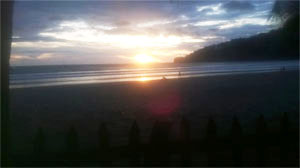 |
Sunset from the Deck in San Juan del Sur |
After a quick check-in at the hotel, we wandered down to the beach and caught up with the round-up dudes who were sitting in a big circle on a large, open-air deck (with roof) as the sun went down. Like anywhere from the tip of South America all the way up to Alaska, Pacific Coast sunsets can be stunning. The sunset in San Juan del Sur that evening was no exception (photo right).
Several of us went out to dinner about 100 meters down the main street from the deck to a restaurant called El Timón. I had been there a couple of times before and never been disappointed. We wandering ROMEOs had reviewed on a previous visit and found it excellent (see El Timón). It was again. I had an outstanding lobster ravioli in a parmesan sauce with a nice lobster tail on top. I know it's roughing it, but we survived.
Two of the four people at our table ordered appetizers as well as main courses and were shocked by the size of the appetizers which were more like main courses. El Timón also presented us with a mystery. My bill for the great ravioli and two cokes came to $18 but when I presented a credit card and it was returned with the bill with an additional 20% discount.
The final bill came to just over $15. Two other diners had the same experience but the one person who paid cash received no discount. Strange, but who's going to fight city hall in a situation like that? I asked around but have yet to receive a satisfactory explanation of this policy. Have I mentioned yet that Nicaragua is one of those places that still is a relative bargain?
After three days in San Juan del Sur, we reversed the travel process and arrived back in Quepos tired but without incident.
¡Va Pues!, amigos (for the meaning of va pues, see What's-in-a-Word below).
For more background info on San Juan del Sur and Nicaragua check these out:
Nicaragua, Granada: Edition 13 - San Juan del Sur and Granada
Navigating Nicaland: Edition 68 - San Juan del Sur and Granada
Nicaragua, Redux: Edition 76 - Revisiting San Juan del Sur
TOP
Quepos Hospital
(It's History and It's Namesake)
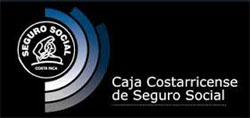 Responsibility for the national health care system in Costa Rica falls under the jurisdiction of the Caja Costarricense de Seguro Social, CCSS, known affectionately as the Caja (cah-hah). CCSS handles both the health system and the social security or retirement system.
Responsibility for the national health care system in Costa Rica falls under the jurisdiction of the Caja Costarricense de Seguro Social, CCSS, known affectionately as the Caja (cah-hah). CCSS handles both the health system and the social security or retirement system.
The Caja operates some 29 hospitals and 250+ clinics throughout the country. The system is funded through payroll deductions of 9% from the employee and another 14% from the employer for a total of 23% of wages & salaries. For those not working here (retired ex-pats for example) there is, of course, a monthly fee for the health care service. For an income of $1,000 per month, that fee would be about $80 and it increases progressively with increasing income level.
We are fortunate that we have one of the CCSS hospitals in Quepos, located about four miles from the center of town very near the airport in an area called La Managua. Quepos Hospital has an interesting history.
The initial surge of development in the village that is now called Quepos began as part of the banana industry expansion which occurred in the 1920's and 1930's. The dominant banana company, La Compania de la Bananeras (CBCR), had been operating in the area (from Parrita down to Golfito) for more than two decades, i.e., the turn of the twentieth century. La Compania essentially and eventually became the Costa Rican division of the United Fruit Company or UFCO. Later United Fruit would become Chiquita Brands International.
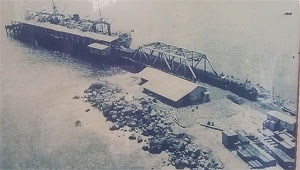 |
Original Dock for Compania Bananeras |
La Compania realized that basic commercial services were needed to support their business and the growing population of workers that kept migrating into the area. Early on they built a basic wooden dock in Quepos bay to ship product to Puntarenas and beyond to San Francisco and Vancouver. A railroad ran right down to the dock to bring the product directly to the ships (photo left).
Sometime Later, La Compania formed the current town of Quepos by blowing up parts of the two mountains, one on either side of the current city limits and filling in the swampy bay between them. And that's how the town of Quepos was born.
This unusual origin is the reason why Quepos is so flat, why the town streets, unlike most roads in the area, are laid out in a north/south, east/west grid pattern more like New York than typical southwest Costa Rica. It's also why these streets even to this day are "spongy", meaning they literally vibrate through a neighborhood with the passing of a heavy truck. One would expect this of a town built on fill with a high water table. GG often confuses the passing of a heavy truck with the potential start of an earthquake (the old dude is easily confused these days).
 |
Escuela Republica de Corea Today |
By the mid to late 1930's, Quepos growth had progressed significantly and the population was increasing because the banana company was attracting more and more workers. By 1939, the first school had been opened under the name Escuela Claudio Pinto. The students met wherever they could find available space. It then became Escuela Doris Stone named after a prominent archaeologist (Harvard) who had studied this area. Later it was again changed to the The Official School of Quepos. Eventually a building complex (photo left) was constructed next to the town football field where it still resides and is now called the Republica de Corea School.
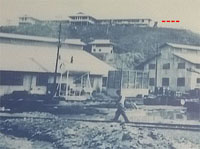 |
Original Quepos Hospital
(top of hill) |
 |
Original Quepos
Hospital Today |
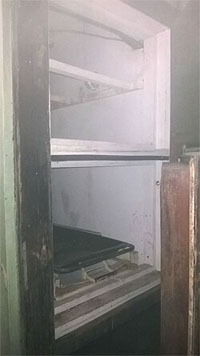 |
The Morgue - Fantasmo? |
La Compania also realized that improvement in basic social services such as medical care was also needed (the national public health department had only been founded in 1927). So the original hospital in Quepos was built by La Compania, as were other hospitals in Limón and Golfito, and finished in 1940. The Quepos Hospital was built in the american zone on a bluff which now overlooks the modern marina (see photo left).
The original wooden building still stands (see photo right with my "guia" [guide] and friend, Jungle Jessie, standing in front). The building is in great disrepair and now used as a storage facility by the canton for trucks and truck parts. Maybe some day it will be restored and become a museum.
While we were there we questioned the guard, a gentleman named Junior, about some reports that the place is haunted. Junior stated that he personally had never seen anything like a fantasma (ghost) at this location. Subsequently, GG took some pictures, one of which was in the old morgue. The pic shown right is of the refrigeration cabinet in the morgue where the bodies were stored. Since showing this picture to several people, three say they can make out a faint semblance of a face in the haze in the top left corner of the photo.
The haze alone is interesting to me since I had cleaned the lens very well before taking the picture and there was no haze in the room when I snapped the picture. GG can't see the image in the photo (but my eyes aren't what they used to be either); can you see it? For more on haunted hospitals in Costa Rica, check out the most famous one: Duran, Duran.
That year (1940) also saw the first power plant completed in Quepos (a distribution facility, I presume, as I don't see a generating plant or the remnants of one anywhere in the area) . The city itself wasn't officially recognized as a city by the federal government until it became part of the newly created Canton (or county) of Aguirre in 1948. Recently the name of the canton was changed from Aquirre (a 1948 civil war hero) to reflect it's most important city, Quepos.
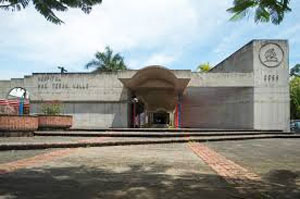 |
| Entrance to Today's Quepos Hospital |
In 1962, the hospital was transferred to the auspices of the national ministry of health known as the Junta de Protección Sociál in San José and renamed in honor of a doctor that played an important role in the overall development of health care in the country and who had become Minister of Health. His name was Dr. Max Terán Valls.
The more modern facility we know today (photo left) and located in the La Managua area near the airport, was not constructed and opened until 1994. It still bears Dr. Max Terán Vall's name on the facade (photo left).
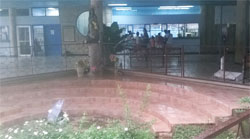 |
Main Atrium at Quepos Hospital ("Estadisticas" Dept. in Background, i.e., File Room) |
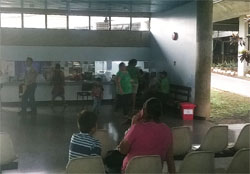 |
Consultorio Section
on a Very Quiet Day |
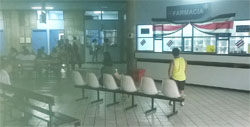 |
Farmacia (Right), Laboratorio (Left and in Background) |
This facility is familiar to GG as I had to visit its emergency room two times in the first seven years of living here and run the gamut of testing they offer. In addition, doctor's visits take place in the Consultorio where I go for preventative check-ups by the doctor that saved my butt from congestive heart failure a few years back. Dios te bendiga, amigo. Dr. Mojarro is Tico-gentle and a very competent physician (gracias a dios por eso, por que estoy un cobarde).
The wait in the Consultorio usually is from one to one and a half hours; it's never been less than 45 minutes and once was two and a half hours. I view the appointment time as simply a point in time when we all gather to hope for our turn (one learns with experience that the policy is first to check-in, first to get served). Suggestion: bring a book to read and dress lightly as there is no air conditioning in the waiting room, just in the doctors and administrative offices. Somewhere during the wait one gets called by a nurse for recording of basic vitals (lost 10 kilos over the last year by watching carbs - BP good as always - Doc's happy).
More routinely, I make a monthly pilgrimage to the hospital to get my prescriptions filled. Yes, this is socialized medicine amigos, and you have often to put up with the bureaucracy that goes with such a system, but once you get used to it, you adjust. I'm not sure I would be as forgiving of the waiting line if I were a Tico with only one day off per week and had to spend virtually all of it in those lines but, for a retired dude like GG, it's much less problematic.
In the case of prescriptions, which also usually takes 1-1.5 hours to fill, I usually make the trip early in the morning (Thursday is a good day for a low people turnout in this department). I drop off the prescriptions at the Farmacia flashing my Caja card and monthly receipt of up-to-date payments ("comprobante"), then go and have breakfast at the Soda Hospital across the street (gallo pinto, scrambled eggs with tomatoes, fried ripe plantains in butter, fruit juice, black coffee). When I'm back in an hour, the scripts are ready.
As mentioned, the namesake of the Quepos hospital is Dr. Máximo Terán Valls who was born on June 12, 1908 in Costa Rica, although exactly where he was born is not easy to find in the current public records. Most likely he wasn't born in Quepos, which was basically a jungle wilderness in 1908. His name is almost always shortened to Dr. Máx Terán Valls or even Máx Terán. Dr. Max first studied medicine in Geneva, Switzerland and then transferred to Barcelona where he graduated as a surgeon on January 7, 1931. During his time in Barcelona he acted as a consul for Costa Rica to Spain, establishing Costa Rican government connections that would be of use to him later.
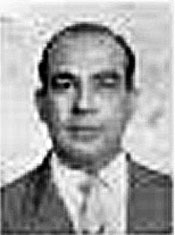 |
Dr. Max Terán Valls |
By October of 1933 Terán had returned to Costa Rica and joined the College of Physicians and Surgeons of Costa Rica. To gain admission to the College, Max wrote a virtual treatise (33 single spaced typed pages) on Obstetrics and Gynecology, a specialty he would favor and love for the rest of his career. The application document very much impressed the medical community. Later he would, several times, become a director of the college.
Terán also chaired the Obstetrics and Gynecology Department at hospital San Juan de Dios. If you've ever driven into downtown San José from the west you can't miss this hospital on Paseo Colón near the Coca-Cola district. He chaired a number of other medical boards as well and became head of the National Ministry of Health (Caja) on two different occasions
.
The good doctor died in 1972. He must have been a humble man as the only photo of him I could find is the one with the rather poor quality to the right. Terán Valls was reported to have had a gentle bedside manner for his patients and there are numerous stories of how he helped women rebound from difficult pregnancies and give birth to normal, healthy children. His personal style and demeanor also helped him reconcile serious differences between competing agencies that he encountered during his ministerial duties.
So this is the man, one of a handful, who was instrumental in upgrading the Costa Rican health care system in the 1950's and 60's. I can personally thank him because I've been to Quepos hospital dozens of times for quarterly consultations with my doctor, laboratory tests or picking up my monthly allocation of medicines. Busses (free if you're over 65 and have a cédula residency document like GG) leave every half hour during the day from a bus stop two blocks from my apartment and arrive at Quepos Hospital about 15 minutes later. It's become routine and easy.
Thanks doc.
¡Solo Bueno!
Here's more from past Chronicles articles on Costa Rican healthcare:
Medical and Dental Care in CR: Edition 49 - Medical Tourism
Costa Rican Health Care: Edition 64 - Part I - The Private System
Costa Rican Health Care: Edition 65 - Part II - The Public System
And for a more wide-ranging assortment of things that relate to health, including local remedies, go here:
More On CR Health/Medical
TOP
A Boruca Story
(Legend of the Quetzal)
Costa Rica has many legends, many of which have come from the "indiginas" (native Americans; often called "indians") before the arrival of Columbus. This is one of them, the Legend of the Quetzal, one of the most beautiful tropical birds in Costa Rica.
This myth comes out of the Boruca indians heritage, a people who dominated the Pacific coast of Costa Rica from Quepos down to the Panama border and beyond and well east into the mountains. The current descendents of this tribe, about 3,000, live on the Reserva Boruca in the south central mountains, the Talamanca region, to this day. Here's how the legend is reported (GG confesses to editing parts of it for grammar and ease of reading, otherwise the narrative is from a translation by Wikipedia):
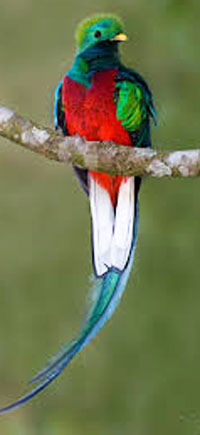 "According to the story of Quetzal, there was a large village with a cacique (chief), who consistently triumphed in leading his followers in wars against other tribes. His wife was going to have a child, and his biggest worry was that he was going to die before his son was born.
"According to the story of Quetzal, there was a large village with a cacique (chief), who consistently triumphed in leading his followers in wars against other tribes. His wife was going to have a child, and his biggest worry was that he was going to die before his son was born.
However, to his advantage and surprise, the enemy tribes ceased their attacks. The cacique had a beautiful son named Satú. The sorcerers of the village were delighted to find that, on the day the baby was born, a beautiful bird perched itself atop a tree branch and began to sing a sweet song. They subsequently gifted Satú with an amulet made of gold, in the shape of the quetzal bird's head. This amulet would be Satú's eternal warrior and protector. Satú grew to be the strongest male in the village and was never injured or debilitated by wars.
His uncle, Labí, was jealous of Satú because he knew that when the cacique died, Satú would be the heir to the throne. Before going to bed, Satú usually took off his amulet and stored it under his head. One night, after Satú had fallen asleep, Labí snuck into his room and stole the amulet.
The next day, when Satú was walking through the forest, he heard a noise and suddenly found that he had been shot by an arrow. Labí came out from behind a bush and smiled triumphantly. As Satú did not have his amulet, he died. At that moment, a quetzal flew over, sat on top of Satú's body for a few moments, and then flew away. Labí was terrified that the quetzal would revive Satú, so he built a fire and burned both Satú and his amulet.
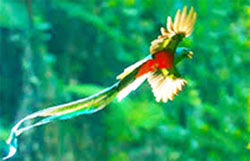 Back at the village, the cacique was worried that something might have happened to Satú. He gathered together his soldiers to investigate. Upon entering the forest, they noticed Satú's footsteps and followed them. They encountered the still burning fire and saw a bloody arrow beside it. The cacique ordered the soldiers to extinguish the fire. After doing so, the soldiers and the cacique cried in silence, lamenting their loss of Satú.
Back at the village, the cacique was worried that something might have happened to Satú. He gathered together his soldiers to investigate. Upon entering the forest, they noticed Satú's footsteps and followed them. They encountered the still burning fire and saw a bloody arrow beside it. The cacique ordered the soldiers to extinguish the fire. After doing so, the soldiers and the cacique cried in silence, lamenting their loss of Satú.
At exactly noon that day, the village heard the sound of a quetzal. The quetzal had long, shiny feathers and was perched in a tree. It then flew away to a mountain, and lived there for eternity. The current belief is that this quetzal bird contains the spirit of Satú. When the tribe fights enemies, they are accompanied by the song of the quetzal and are always victorious." (Source: Wikipedia)
Well, we have very few tribal wars anymore but we do have a lot of Quetzals. GG is particularly interested in these legends because he's in the middle of researching the habits and practices of pre-Columbian indians for a book he's writing based on another legend. Costa Rica is rich in mystical, mysterious and sometimes spiritual stories and myths that provide a fertile backdrop for many a story.
For more on other legends of Costa Rica, go here: Legends of Costa Rica
¡Pura Vida!
TOP
Travel Quote of the Month
GG was recently on a Spirit Airlines flight (NK 755) from Fort Lauderdale to San José. We had to make a quick diversion shortly after taking off to avoid a large storm moving up the peninsula from Key West. At one point we encountered heavy turbulence, the kind that made half the people in the cabin issue loud expletives deleted. It only lasted about 10-15 seconds (seemed like minutes) and when we had cleared the bumps the pilot came on to say:
"OK, who wants to get out now!?" |
What's-in-a-Word
Va Pues
This is pronounced as "vah pway". This term was another interesting thing learned on the latest trip to Nicaragua. When a Tico says something like "¿Como le va?" or "How's it going?" a typical answer is "Esta Bien" or "OK" (actually the response is often slurred to "..stah bien". The more typical Nica response is Va Pues.
¿Que Es Eso?
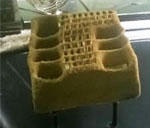 If you travel by bus locally here or in other parts of Costa Rica you know that the item pictured is a block of sponge foam, out of which has been carved or cut, a number of openings that can house coins. The big holes are for individual loose coins while the slots are used to keep certain pre-counted combinations to make correct change from a 500 colon coin or a 1,000 Colon note.
If you travel by bus locally here or in other parts of Costa Rica you know that the item pictured is a block of sponge foam, out of which has been carved or cut, a number of openings that can house coins. The big holes are for individual loose coins while the slots are used to keep certain pre-counted combinations to make correct change from a 500 colon coin or a 1,000 Colon note.
Bus drivers here use this system to speed up the change-making process as they collect bus fares. I call it a "CDD", a Change Disbursement Device. We must have some of the most talented bus drivers in the world as they are able to load the CDD while the bus is in motion and at the same time field a cell phone call. Who said Ticos were not good at multi-tasking.
TOP
ROMEO Corner
(Retired Old Men Eating Out)
La Cantina - Manuel Antonio
Location: From El Avion (plane) restaurant at the top of Manuel Antonio go about 300 meters down the main road in the direction towards the beach- on the right.
Hours: Monday to Sunday, dinner only, 5-11 PM
Parking: Ample off-street at the restaurant
Contact: Tel.: 2777-0584; Email: reservations@costaverde.com ; Website: www.lacantinabbq.com
Reviewing ROMEOS: Alma L., May M., Lance M., Brian M., Bob N.
To Review Our Rating System and Procedure, go here: R.O.M.E.O. Rating System
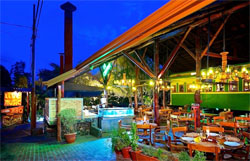 La Cantina is part of the Costa Verde hotel complex that includes Costa Verde Hotel and also the restaurants Anaconda, El Avion and El Wagon. It is a sizeable restaurant with a rustic motif situated on the edge of the rainforest and a lot of local wood is employed in the building itself as well as the tables.
La Cantina is part of the Costa Verde hotel complex that includes Costa Verde Hotel and also the restaurants Anaconda, El Avion and El Wagon. It is a sizeable restaurant with a rustic motif situated on the edge of the rainforest and a lot of local wood is employed in the building itself as well as the tables.
The restaurant does not have an ocean view like the El Avion but is moderately lit (two of us old fogies still used a penlight to read the menu). The wood tones make for a pleasant dining atmosphere. The owners here love a motif theme - the Ollie North plane at the El Avion, for example and at La Cantina you'll find a full size railroad dining car now used as a bar.
For atmosphere and ambiance we give La Cantina four sloths.
The restaurant builds itself as having a barbecue theme but the menu offers a food range of seafood, pastas, steaks and salads. Two of us chose a Paraguayan lomito with a crispy sauce (as best as I could understand that one is that it's a blend of the grilling juices, cream and some spices - served on the side). The meat was a sizeable piece and tasty as was the sauce.
I also found the beef tender although it didn't seem like a a piece grilled on a wood fire as suggested by the open oven. The other diner who ordered the lomito was not as positive about the tenderness or flavor - average said he (de gustibus non disputandem est - there is no disputing taste - the nuns would be happy that I remembered that one).
Other diners ordered fish and meat brochettes and reported them satisfactory.
|
 |
|
$$$$ |
Value Index = 100 |
For food quality we give La Cantina four sloths.
Service was friendly but reserved (professional might be a better word), efficient and attentive. For atmosphere, food quality and service we give La Cantina an overall rating of four sloths.
GG had three courses (breaded mushrooms, the lomito and a square of torte chileno), a coke and a coffee and my bill came to $42. This puts the cost index one level below the most expensive in the area and gives La Cantina a cost rating of 4$ and a value index of 4/4x100=100.
La Cantina is another good option for dining in the Manuel Antonio/Quepos area and is priced fairly compared to other restaurants here. Buen provecho!
Golden Gringo Chronicles Novel and E-Books Now Available!
 The story of the Golden Gringo Chronicles is also available as a hard copy novel of 192 pages available through Amazon and all major online retailers. ($9.95)
The story of the Golden Gringo Chronicles is also available as a hard copy novel of 192 pages available through Amazon and all major online retailers. ($9.95)
Amazon link: GGC, the Book. (Kindle Edition available)
Follow GG through the first six years of his odyssey in making the decision to retire in Costa Rica, overcoming the trials and tribulations of moving and obtaining residency there and the fun and experience of actually living in Ticoland.
Ride along with the Golden Gringo as he learns about the rich, varied culture of Costa Rica, the incredible bio diversity, the charming nature of the Costa Rican people and the ease with which a sometimes clueless ex-pat can assimilate into a small southwestern town on the Pacific coast.
Whether you are already a Costa Rican resident, someone contemplating a move here or just a traveler who enjoys different cultures, you will find the Golden Gringo Chronicles interesting, entertaining and informative about Costa Rica.
A narrative version of the Golden Gringo Chronicles is now also available as a trilogy of E-books in formats compatible with virtually all electronic platforms.
Part 1: (FREE!)
Leaving the Homeland
Part 2: ($3.99)
The Early Years
Part 3: ($3.99)
Becoming Tico, Maybe
Click on Part Number above for E-book sample downloads or click the price above right for purchase. (The best price is on Part 1; it's FREE)
Opt-In Here to Receive Your Free Copy Monthly
The Golden Gringo Chronicles is a free newsletter that is non-political, non-commercial and, hopefully, entertaining. By signing up you will receive an email each month around the first of the month giving you the links to the latest edition as well as to each individual feature and departmental section.
CLICK HERE TO SIGN-UP FOR THE
GOLDEN GRINGO CHRONICLES
or Email me at gg@goldengringo.com

The Golden Gringo
Pura Vida!
To Contact GGC World Headquarters (yuk, yuk) to make comments, suggest topics or criticize my bad jokes, just send an email to: bob@bobnormand.com.
Be pithy but kind; I'm sensitive.
Unsubscribe from Golden Gringo Chronicles
 “No, that is the great fallacy: the wisdom of old men. They do not grow wise. They grow careful.”
“No, that is the great fallacy: the wisdom of old men. They do not grow wise. They grow careful.”

 A case in point: In late September, ARESEP announced that in October, the price of regular gasoline would drop to 540 colones per liter. At 530 colones to the dollar, that is equivalent to $3.83 per gallon. This struck me particularly high because two weeks earlier I paid $2.20 per gallon to fill up a rental car in Florida.
A case in point: In late September, ARESEP announced that in October, the price of regular gasoline would drop to 540 colones per liter. At 530 colones to the dollar, that is equivalent to $3.83 per gallon. This struck me particularly high because two weeks earlier I paid $2.20 per gallon to fill up a rental car in Florida.  Last month the Chronicles did a feature (see
Last month the Chronicles did a feature (see 
 September/October is a time along this coast when large numbers of whales and dolphins appear. It's mating time.
September/October is a time along this coast when large numbers of whales and dolphins appear. It's mating time.

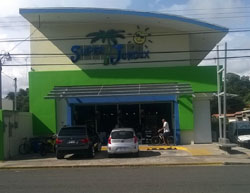
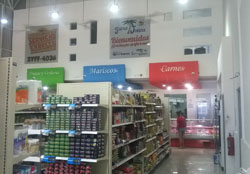
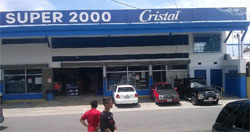
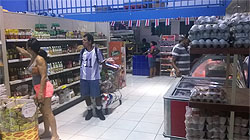
 A new department has been added this month called
A new department has been added this month called  The second improvement has to do with making it easier to access the considerable amount of information contained in the Golden Gringo Chronicles Archives. Spanning all the departments and the more than 170 feature articles in the 87 editions to date, it comes to almost 500,000 words or about 9 average length novels according to Amazon. This edition alone clocks in at more than 7,100 words.
The second improvement has to do with making it easier to access the considerable amount of information contained in the Golden Gringo Chronicles Archives. Spanning all the departments and the more than 170 feature articles in the 87 editions to date, it comes to almost 500,000 words or about 9 average length novels according to Amazon. This edition alone clocks in at more than 7,100 words. ¿Que Es Eso? is Spanish for "What is that?". This department is new to the Chronicles with this month's issue. In it we will try to highlight, with photos, those things that seem common in Costa Rica life, particularly in Quepos and Manuel Antonio, but are probably not to be found elsewhere.
¿Que Es Eso? is Spanish for "What is that?". This department is new to the Chronicles with this month's issue. In it we will try to highlight, with photos, those things that seem common in Costa Rica life, particularly in Quepos and Manuel Antonio, but are probably not to be found elsewhere.
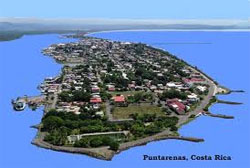
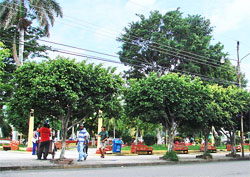
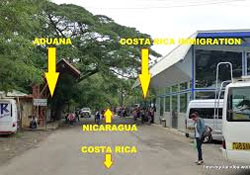
 The ride from the border to San Juan del Sur takes less than an hour and the typical fare, we would learn later, is $20-25 although we paid a little more on this trip. Splitting the two fares among several of us made it very reasonable. On our return trip three of us paid a total of only $20 plus tip.
The ride from the border to San Juan del Sur takes less than an hour and the typical fare, we would learn later, is $20-25 although we paid a little more on this trip. Splitting the two fares among several of us made it very reasonable. On our return trip three of us paid a total of only $20 plus tip.
 Responsibility for the national health care system in Costa Rica falls under the jurisdiction of the Caja Costarricense de Seguro Social, CCSS, known affectionately as the Caja (cah-hah). CCSS handles both the health system and the social security or retirement system.
Responsibility for the national health care system in Costa Rica falls under the jurisdiction of the Caja Costarricense de Seguro Social, CCSS, known affectionately as the Caja (cah-hah). CCSS handles both the health system and the social security or retirement system.









 "According to the story of Quetzal, there was a large village with a cacique (chief), who consistently triumphed in leading his followers in wars against other tribes. His wife was going to have a child, and his biggest worry was that he was going to die before his son was born.
"According to the story of Quetzal, there was a large village with a cacique (chief), who consistently triumphed in leading his followers in wars against other tribes. His wife was going to have a child, and his biggest worry was that he was going to die before his son was born.  Back at the village, the cacique was worried that something might have happened to Satú. He gathered together his soldiers to investigate. Upon entering the forest, they noticed Satú's footsteps and followed them. They encountered the still burning fire and saw a bloody arrow beside it. The cacique ordered the soldiers to extinguish the fire. After doing so, the soldiers and the cacique cried in silence, lamenting their loss of Satú.
Back at the village, the cacique was worried that something might have happened to Satú. He gathered together his soldiers to investigate. Upon entering the forest, they noticed Satú's footsteps and followed them. They encountered the still burning fire and saw a bloody arrow beside it. The cacique ordered the soldiers to extinguish the fire. After doing so, the soldiers and the cacique cried in silence, lamenting their loss of Satú. 
 La Cantina is part of the Costa Verde hotel complex that includes Costa Verde Hotel and also the restaurants Anaconda, El Avion and El Wagon. It is a sizeable restaurant with a rustic motif situated on the edge of the rainforest and a lot of local wood is employed in the building itself as well as the tables.
La Cantina is part of the Costa Verde hotel complex that includes Costa Verde Hotel and also the restaurants Anaconda, El Avion and El Wagon. It is a sizeable restaurant with a rustic motif situated on the edge of the rainforest and a lot of local wood is employed in the building itself as well as the tables. 




